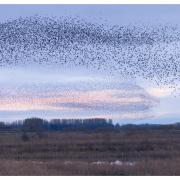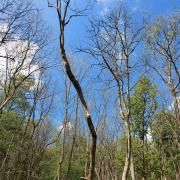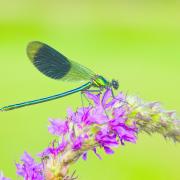With a bit of searching, patience and luck all five species of owl that call Yorkshire home can be easily spotted, says Jono Leadley from Yorkshire Wildlife Trust.

Special encounters
Dusk on the bank of the mighty River Humber. The air is filled with the melancholy cries of golden plover as they pass overhead in the gathering gloom. Out of the corner of my eye, a pale bird appears, flapping low across the saltmarsh like a giant, stiff-winged moth. It is a short-eared owl; a bird of wild, open spaces, searching for small mammals.
I hunker down in the grass as the silent hunter approaches, alighting without sound on a fencepost. For a moment, this beautiful bird is unaware of my existence, peering intently across the marsh. Suddenly, the owl senses my presence, swivels its head around and glares at me with fierce yellow eyes. The spell is broken and off it flies along the course of an old ditch, like a spectre drifting through the mist, leaving me breathless with excitement.
Every encounter with an owl is special. They are charismatic, beautiful and deadly; denizens of wild places and darkness. Their forward-facing eyes, set in a rounded facial disc, give them an intelligent look – contributing to their standing as the wisest of birds in folklore and stories.

High-spec design
The feathers forming an owl’s face have evolved like a satellite dish to capture the tiniest sounds, and funnel them to the ears hidden in the feathers at the side of the head. Don’t be fooled by the ear-tufts of long-eared and short-eared owls – they are just feathers! Owl ears are not symmetrical; one is a little higher than the other, which gives an owl the ability to accurately pinpoint sounds. Owls have amazing aural memories. Having heard and pinpointed a sound, a flying owl can then change course, turn, and locate the precise spot without needing to hear the call again.
It is logical to assume that the soft feathers of an owl, which permit silent flight, are designed so potential prey are unaware of an its approach. This is definitely an advantage, but the main reason seems to be that the sound of the its wings does not drown out the noise made by its prey. Combining this high-spec hearing with a pair of sharp, forward-facing eyes means not much goes unnoticed by a hunting owl. Owls are well-known for their ability to swivel their heads around – not completely of course, but at least 180 degrees. This means an owl can move its detection gear around, while keeping everything in sync.
Barn owls, and our two ‘eared’ owls all hunt in flight. For relatively light birds, they have long, rounded wings, which enable them to spend long periods quartering back and forth, searching for prey. Tawny and little owls, more associated with wooded areas, adopt a more ‘sit and wait’ approach on a post or bough.

Conservation
Sadly, like much of Yorkshire’s wildlife, owl populations have suffered through loss of habitat, changes in farming practise, and increased development and roads. The result is that there is not as much space left for these beautiful birds. Concerted conservation efforts over the years have helped species like barn owls bounce back and in some areas – notably the Yorkshire Wolds and Lower Derwent Valley – the populations are healthy. Nevertheless, our owls still face many threats. As feeding grounds become isolated by intensive agriculture and developments, they are forced to travel further between nest sites and hunting areas, and this increases the risk of collisions with vehicles when crossing roads. In some areas, grasslands alongside busy roads attract owls, often with fatal consequences.
Some hazards are more natural. Prolonged cold or wet spells, particularly late in the winter can be disastrous, for example. If there is deep snow cover preventing access to small mammals, owls simply can’t find food and will starve to death. Owl breeding success and survival is also linked to the abundance of prey; small mammals, such as voles, are a main food source for our ‘eared’ and barn owls. Vole populations go in cycles, with numbers increasing rapidly over a few years, before a huge crash. Owl populations follow these cycles, with great breeding success in ‘vole years’ when food is plentiful, followed by dreadful years when prey abundance crashes.
Tawny owls have a much more varied diet, from frogs to birds and even worms and slugs, and this gives them more options when prey is scarce. Consequently, their populations tend to fluctuate less.

Where to look and listen
Tawny owls are the most widespread of the Yorkshire owls, occurring in and around our towns and villages, and wherever there are large trees for them to nest in. Despite this status, they are rarely seen as they are strictly nocturnal. You are much more likely to hear the quavering hoot of the male or the sharp ‘kewick’ contact call after dark. Tawnies breed early in the year, so by early autumn they are re-establishing their territories – chasing away that season’s fledged young with much calling.
Short-eared and barn owls can be found hunting in daylight, particularly early and late in the day. They hunt over open grasslands and marshes, where voles are common. Long-eared owls are scarce breeders, usually confined to thick pine forests, heathlands and scrubby areas. In winter, they form communal roosts in thick scrub which are sometimes visible. A number of nature reserves around Yorkshire host these roosts, although they vary from year to year. Numbers of both short-eared and long-eared owls are swollen in autumn, with the arrival of migrants from northern Britain and Scandinavia. In some years, impressive arrivals of both species occurs at the coastal watch-points of Spurn and Flamborough Head, with October and November being a good time to spot both species.
Our fifth owl, the little owl, inhabits wooded parkland, farmland with big hedgerows and old trees, and likes permanent grassland – where it can seek out earthworms, beetles and the like. They can be quite active during daylight, often perching on roadside telegraph pole or fencepost.



























